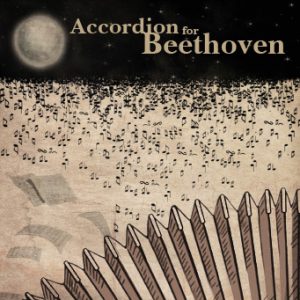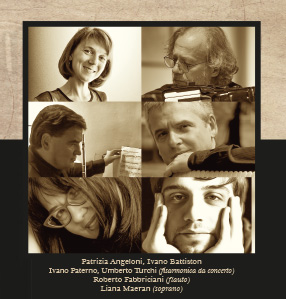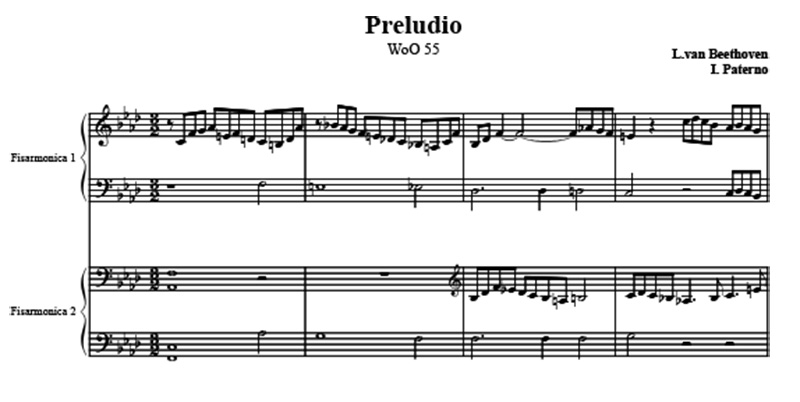“Accordion for Beethoven” – Le trascrizioni di Ivano Paterno
 Ancora un fisarmonicista, nella doppia veste di trascrittore ed esecutore, per il progetto Accordion for Beethoven (una collezione di trascrizioni, un CD ed un album digitale editi da Ars Spoletium Music Publishing): si tratta di Ivano Paterno, impegnato nella trascrizione e nell’esecuzione del Preludio WoO 55, oltre che nella esecuzione di una serie di piccoli pezzi tratti dalle opere WoO 13, WoO 11 e WoO 31.
Ancora un fisarmonicista, nella doppia veste di trascrittore ed esecutore, per il progetto Accordion for Beethoven (una collezione di trascrizioni, un CD ed un album digitale editi da Ars Spoletium Music Publishing): si tratta di Ivano Paterno, impegnato nella trascrizione e nell’esecuzione del Preludio WoO 55, oltre che nella esecuzione di una serie di piccoli pezzi tratti dalle opere WoO 13, WoO 11 e WoO 31.
Del Preludio WoO 55, pubblicato a Vienna nel 1805 e trascritto dal Paterno per due fisarmoniche (pubblicato da Ars Spoletium), non è pervenuto il manoscritto e diverse sono le ipotesi sull’anno di composizione: 1787, 1795 e 1803 (anno in cui era stata approntata una stesura per una pubblicazione poi non realizzata). Luigi Della Croce propende per il 1787, chiedendosi anche come potesse il giovane Beethoven aver già così ben acquisito “[…] le regole della musica e in particolare lo stile bachiano, che in questa limpida pagina ha un suo cultore tutt’altro che principiante?[…]”. La destinazione strumentale riportata nella prima edizione è per il pianoforte, ma, per la peculiare trama polifonica del preludio, questo lavoro è spesso realizzato all’organo.
Dall’introduzione firmata da Ivano Paterno, leggiamo: “Va detto che, anche se la critica spesso attribuisce la tecnica compositiva di questo preludio agli studi dello stile bachiano, esso si discosta oramai molto, dopo quasi mezzo secolo dalla morte di Bach, dal suo stile polifonico, il colore delle trame contrappuntistiche non ha oramai quasi più nulla della espressione estremamente fantasiosa, anche se rigorosa, di Bach; l’armonia si è incamminata su strade che porteranno molto lontano dalle consuetudini barocche e in alcuni punti già traspaiono. Quel che resta, quasi come un segno di riconoscimento stilistico dell’epoca precedente, è la continuità del movimento ritmico in crome (in tempo di tre metà), vivificata dall’anacrusi tematica, che pervade in maniera ostinata tutto il pezzo con l’inserimento in contrappunto di alcuni episodi monodici a note più lunghe nella parte del Basso che riecheggiano come un desueto e timido “cantus firmus”. La versione per due fisarmoniche, a preferirla ad una per “solo”, nasce dall’esigenza di rendere compiuta e ben percepibile una trama polifonica a volte intricata e con particolari di sovrapposizione di registro e di risonanze che su uno strumento solo obbligherebbe a scelte di articolazione e disposizione sulle due tastiere, a mio avviso, non opportune”.
 Il Preludio è interpretato, in Accordion for Beethoven, dallo stesso Ivano Paterno in duo con Ivano Battiston. Il CD e l’album digitale contengono anche l’incisione di alcuni piccoli pezzi, per lo più in forma di danza, già trascritti e pubblicati precedentemente da Battiston per le edizioni Berben/Curci, ora riprese, in parte rielaborate ed eseguite da Ivano Paterno proprio per Accordion for Beethoven, che così le introduce: “Le danze presentate, che nel loro insieme risalgono agli anni Novanta del XVIII secolo, sono raggruppate in diverse raccolte (WoO 11, WoO 13, WoO 31) e sono da ascrivere all’attività mondana a cui i compositori erano spesso chiamati per allietare le feste di corte e la vita di società. Questi pezzi, in particolare, sono stati scelti da Ivano Battiston da versioni pianistiche, anche di lavori originariamente dedicati agli archi, ed inseriti nella raccolta “Hallo” dedicata a Beethoven (ed. Curci/Berben) per la loro immediatezza tecnica. La semplicità strumentale che li contraddistingue li rende adatti, oltre che a realizzare delle miniature da concerto, anche ad un percorso didattico: il giovane fisarmonicista nel dedicarsi al repertorio da intrattenimento è spesso traviato da adattamenti impropri o da composizione di dubbio valore musicale e con questa raccolta di danze ha l’opportunità di eseguire in versione integrale un repertorio che lo avvicina ad alcuni modelli della musica cosiddetta “da ballo” accompagnato dalla mano di un grande musicista. La registrazione comprende tutti i pezzi della raccolta Curci/Berben (12 numeri) con l’aggiunta di un’ulteriore danza (traccia n. 3) e l’ampliamento della danza n. 5 (traccia n. 8) che nella raccolta a stampa è limitata al primo Trio per ragioni dovute alla sua destinazione didattica. La raccolta comprende anche il tema del popolare motivo russo Schöne Minka (traccia n. 12), realizzato nel seguito integralmente da Ivano Battiston e Roberto Fabbriciani alla traccia n. 23, e una piccola fuga a tre voci”.
Il Preludio è interpretato, in Accordion for Beethoven, dallo stesso Ivano Paterno in duo con Ivano Battiston. Il CD e l’album digitale contengono anche l’incisione di alcuni piccoli pezzi, per lo più in forma di danza, già trascritti e pubblicati precedentemente da Battiston per le edizioni Berben/Curci, ora riprese, in parte rielaborate ed eseguite da Ivano Paterno proprio per Accordion for Beethoven, che così le introduce: “Le danze presentate, che nel loro insieme risalgono agli anni Novanta del XVIII secolo, sono raggruppate in diverse raccolte (WoO 11, WoO 13, WoO 31) e sono da ascrivere all’attività mondana a cui i compositori erano spesso chiamati per allietare le feste di corte e la vita di società. Questi pezzi, in particolare, sono stati scelti da Ivano Battiston da versioni pianistiche, anche di lavori originariamente dedicati agli archi, ed inseriti nella raccolta “Hallo” dedicata a Beethoven (ed. Curci/Berben) per la loro immediatezza tecnica. La semplicità strumentale che li contraddistingue li rende adatti, oltre che a realizzare delle miniature da concerto, anche ad un percorso didattico: il giovane fisarmonicista nel dedicarsi al repertorio da intrattenimento è spesso traviato da adattamenti impropri o da composizione di dubbio valore musicale e con questa raccolta di danze ha l’opportunità di eseguire in versione integrale un repertorio che lo avvicina ad alcuni modelli della musica cosiddetta “da ballo” accompagnato dalla mano di un grande musicista. La registrazione comprende tutti i pezzi della raccolta Curci/Berben (12 numeri) con l’aggiunta di un’ulteriore danza (traccia n. 3) e l’ampliamento della danza n. 5 (traccia n. 8) che nella raccolta a stampa è limitata al primo Trio per ragioni dovute alla sua destinazione didattica. La raccolta comprende anche il tema del popolare motivo russo Schöne Minka (traccia n. 12), realizzato nel seguito integralmente da Ivano Battiston e Roberto Fabbriciani alla traccia n. 23, e una piccola fuga a tre voci”.
Così, là dove la sonorità del pianoforte aveva tradotto e addolcito la natura popolare delle danze, la fisarmonica da concerto recupera la sua anima popolare e si “appropria”, col gesto antico che le appartiene, dei contenuti musicali originari, trattando però il suono con l’eleganza e la competenza che si deve alla scrittura beethoveniana.
Accordion for Beethoven. Un progetto di Patrizia Angeloni per Ars Spoletium, in collaborazione con “Strumenti&Musica Magazine” e il patrocinio del Nuovo C.D.M.I.
La partitura
Ludwig van Beethoven, Preludio WoO 55, trascrizione per due fisarmoniche da concerto di Ivano Paterno, Ars Spoletium, 2020, pp. 8
SCARICA LA TRASCRIZIONE
ACQUISTA IL CD
ASCOLTA LE TRACCE DEL DISCO
————————————————————————————
“Accordion for Beethoven” – Ivano Paterno’s transcriptions
 Once again, an accordionist, in the double role of transcriber and performer, for the project Accordion for Beethoven (a collection of transcriptions, a CD and a digital album published by Ars Spoletium Music Publishing): Ivano Paterno engaged in the transcription and interpretation of the Prelude Woo 55 in addition to the interpretation of a series of small pieces from the works Woo 13, Woo 11 and Woo 31.
Once again, an accordionist, in the double role of transcriber and performer, for the project Accordion for Beethoven (a collection of transcriptions, a CD and a digital album published by Ars Spoletium Music Publishing): Ivano Paterno engaged in the transcription and interpretation of the Prelude Woo 55 in addition to the interpretation of a series of small pieces from the works Woo 13, Woo 11 and Woo 31.
Published in Vienna in 1805 and trenscripted by Paterno for two accordions (published by Ars Spoletium), this is a work the manuscript of which has not survived, and there are several hypotheses regarding the year in which it was composed: 1787, 1795 or 1803 (the year in which a draft was prepared for a publication which hasn’t appeared, though). Luigi Della Croce tends to believe that it was 1787, also wondering how the young Beethoven could have already acquired such a proficiency in «the rules of music and, in particular, in the Bachian style, which in this pristine page of music finds a convert who is all but a beginner…». The instrumental destination reported in the first edition is for the piano but, because of the peculiar polyphonic texture of this prelude, the work is often performed on the organ.
From the introduction by Ivano Paterno, we read: «It must be said that, even if the reviewers often attribute this prelude’s compositional technique to the studies of the Bachian model, the style here is quite different; almost half a century after Bach’s death, Beethoven’s polyphonic writing has distanced itself from that of his predecessor; the color of the contrapuntal plots has almost nothing more to share with Bach’s extremely imaginative, albeit rigorous, expression; harmony has set out along roads that will lead far away from the baroque tradition, and in some places its originality already appears clearly. What remains, almost as a sign of stylistic recognition of the previous era, is the continuity of the rhythmic movement in eighth notes (in 3/2 time), enlivened by the thematic anacrusis, which obstinately pervades the whole piece with the insertion in counterpoint of some monodic episodes with longer notes in the bass, that echo like an obsolete and shy cantus firmus. The version for two accordions, preferable to that for “solo” arises from the need of rendering a sometimes intricate polyphonic plot, making it sound complete and clearly perceptible, including many details of overlapping register and resonances that, on a solo instrument, would bring the performer to choices of articulation and arrangement on the two keyboards which, in my opinion, wouldn’t result appropriate».
 The Prelude is interpreted, in Accordion for Beethoven, by Ivano Paterno himself in duo with Ivano Battiston. The CD and the digital album also contain the recording of some small pieces, mostly in dance form, previously transcribed and published by Battiston for the Berben/Curci editions, now resumed, partly reworked and performed by Ivano Paterno just for Accordion for Beethoven. From the introduction: «The dances which are presented here, dating back as a whole to the 1790s, are grouped into different collections (Wo0 11, Wo0 13, Wo0 31) and should be ascribed to the worldly activity to which composers were often called, to cheer up court parties and high society’s life. These pieces, in particular, had been chosen by Ivano Battiston from piano versions, also of works originally dedicated to strings, and included in the “Hallo” collection dedicated to Beethoven (ed. Curci / Berben) because of their uncomplicate technical approach. The instrumental simplicity which characterizes them makes them suitable not only as concert miniatures, but also for educational purposes: the young accordionist, while devoting himself to the entertainment repertoire, is often misled by improper arrangements or by compositions of questionable musical value; instead, by practicing this collection of dances, he has the opportunity to perform the complete version of a repertoire that brings him closer to some models of so-called “light” or “dance” music, while following a great musician’s footprints. This recording includes all the pieces printed in the Curci / Berben collection (12 numbers) with the addition of a further dance (track n. 3) and of the enlarged version of the dance n. 5 (track n. 8) which in the printed collection includes only the first Trio, to make it more suitable for its didactic destination. The collection also includes the theme of the popular Russian motif “Schöne Minka” (track n. 12), entirely realised and performed by Ivano Battiston and Roberto Fabbriciani on track n. 23, and a small three voices fugue».
The Prelude is interpreted, in Accordion for Beethoven, by Ivano Paterno himself in duo with Ivano Battiston. The CD and the digital album also contain the recording of some small pieces, mostly in dance form, previously transcribed and published by Battiston for the Berben/Curci editions, now resumed, partly reworked and performed by Ivano Paterno just for Accordion for Beethoven. From the introduction: «The dances which are presented here, dating back as a whole to the 1790s, are grouped into different collections (Wo0 11, Wo0 13, Wo0 31) and should be ascribed to the worldly activity to which composers were often called, to cheer up court parties and high society’s life. These pieces, in particular, had been chosen by Ivano Battiston from piano versions, also of works originally dedicated to strings, and included in the “Hallo” collection dedicated to Beethoven (ed. Curci / Berben) because of their uncomplicate technical approach. The instrumental simplicity which characterizes them makes them suitable not only as concert miniatures, but also for educational purposes: the young accordionist, while devoting himself to the entertainment repertoire, is often misled by improper arrangements or by compositions of questionable musical value; instead, by practicing this collection of dances, he has the opportunity to perform the complete version of a repertoire that brings him closer to some models of so-called “light” or “dance” music, while following a great musician’s footprints. This recording includes all the pieces printed in the Curci / Berben collection (12 numbers) with the addition of a further dance (track n. 3) and of the enlarged version of the dance n. 5 (track n. 8) which in the printed collection includes only the first Trio, to make it more suitable for its didactic destination. The collection also includes the theme of the popular Russian motif “Schöne Minka” (track n. 12), entirely realised and performed by Ivano Battiston and Roberto Fabbriciani on track n. 23, and a small three voices fugue».
Thus, where the sound of the piano had translated and softened the popular nature of the dances, the concert accordion retrieves its popular soul and “appropriates”, with the ancient gesture that belongs to it, the original musical contents, but treating the sound with the elegance and competence that is due to Beethoven’s writing.
Accordion for Beethoven. A project by Patrizia Angeloni for Ars Spoletium, supporting by Strumenti&Musica Magazine and Nuovo C.D.M.I.
Music scores (transcription by Ivano Paterno):
Ludvig van Beethoven, Preludio woO 55, trascrizione per due fisarmoniche da concerto di Ivano Paterno, Ars Spoletium 2020, pp. 8
DOWNLOAD THE TRANSCRIPTION
PURCHASE THE ALBUM ONLINE
LISTEN TO THE SONGS

